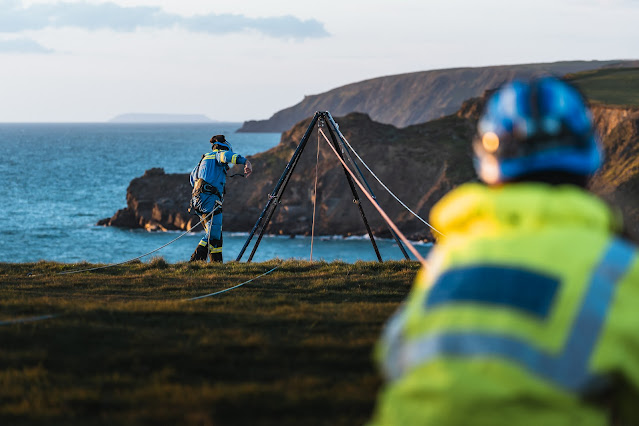VIDEO: Family with young children winched to safety after tide forces them up cliff
A family has been winched to safety after clambering up a cliff face to avoid the incoming tide.
The two adults
and two children found themselves cut off on the rocks below Llansteffan Castle,
as waves battered the rocks they were on.
But the addition of a high visibility jacket on one of the four meant the helicopter was quickly able to spot them and go to their rescue.
They were also fortunate
that a passer-by spotted the trouble they were in as the tide came in and
reported it to the coastguard, allowing teams to get to them ‘in the nick of
time’.
*Video has no sound
George Close,
maritime commander for HM Coastguard, said: “This family were out for a lovely
evening stroll along the beautiful sandy beaches overlooked by the ruins of
Llansteffan Castle when they found themselves cut off by the tide and in danger
of being swept away.
“It is really
important to take note of the local warning signs – and check the tide times,
it’s easy to do with a quick search online or download an app.
“What looks
like an ideal spot for a walk is actually the mouth of the Towy estuary into
Carmarthen Bay and, when the tide comes back in, those sandy beaches quickly
disappear under fast-flowing water.
“It turns
treacherous in minutes, as this family quickly found out. It’s easy to take
your eye off safety for a moment, and that’s all you need to be in big trouble.”
 |
| Coastguard Rescue Teams are sometimes able to recover people to safety up a cliff but, depending on the terrain, a helicopter can sometimes be needed Picture: James McEwan |
A call came in
shortly after 3.15pm on Sunday lunchtime from a person concerned about the
safety of four people on the beach at Llansteffan, as he saw the tide was on
its way in and suspected that they were already cut off.
Llansteffan
Coastguard Rescue Team and Ferryside Independent Lifeboat were sent to conduct
a search and locate the casualties – with the lifeboat spotting them within
minutes of launching. They were in a crevice in the cliff below the castle.
But this rocky
terrain, accompanied by the strength of the swell on the estuary prevented a
rescue from either the land-based or water-based teams, and the Coastguard
helicopter was requested.
The St Athan
helicopter crew were quickly on hand and were able to winch the family to
safety and end their scary ordeal.
George added: “The
evenings are also getting darker earlier and quicker and we would ask people to
bear this in mind when planning a trip, it’s much harder to find your way to
safety in the dark.
“Fortunately they were wearing high-vis jackets and that really helped the helicopter to spot them and winch them to safety. They were also very lucky the passer-by called it in, as it allowed us to get to them in the nick of time.”
High tide means the water is in and the beach
will be at its smallest/least exposed. Sometimes beaches disappear completely
during high tide.
Low tide means the water is out and the level of
water is at its lowest. This might mean a beach is entirely exposed or walkways
become accessible. St Michael’s Mount is an example of this.
Some places
experience mild changes between high and low tide whereas other
spots see vast differences.
Remember: High
tide and low tide are the turning points, but the water is always on its
way in or on its way out. It is vital to know when these times are, to ensure
you do not get caught out.
Estuaries are some of the UK’s most dangerous
places to walk on, due to quicksand-like mud pits and the speed that the tide
can come back in. This is known as a tidal bore or surge. The River Severn’s is
the most famous tidal bore.


